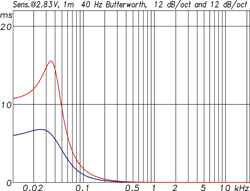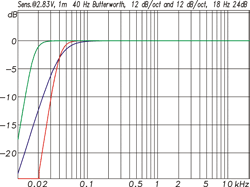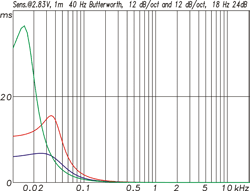Altec midbass solutions Kedar has been talking about are creative and fitting for what they have been designed for but we should not forget that they are ported boxes with partial horn load. The dual flh solution Cessaro introduced or @christensenleif@msn.com 's solution is a step above these but they do not cover as low as these ported solutions and you need bass below them. It is always a choice. If you like what you are getting from ported mid-bass horns that is a very acceptable preference but they will have group delay around their port frequencies. For people who may not know, group delay is the time it takes for an electrical input signal to become an acoustical output. I have experienced with friends that this can actually become a preference for them and they translate it in " audiophile terminology" to a "less dry bass".
The second thing with the ported bass/midbass solutions is, they are hard to mate with bass without causing non-lineer disruptions in response. Maybe it is better to keep them cover it all down to 60hz or 50hz they work down to. Do not get me wrong, nearly everybody in the world who has some speakers with subs either is trying to make a ported speaker and a sealed sub, or a ported speaker and a ported sub work together, so even if you do, it is very normal and generally applied solution that people are happy with and not just people, mixing engineers as well. I have spent a fair amount of time around studios and had listened to a lots and lots of ported studio monitors at them. I still have three sets of ported studio monitors from those days in the garage. So, even some of the mixes are based upon that loose bass the engineers were hearing on their ported monitors and that effects how they mix...
As you dive deeper, you find no single truth, no single solution will work in all cases. I prefer the so called dry bass (less group delay). I have gone through these solutions one by one, listened and measured them and in time found my own preference. Physically it is a better measuring solution and is also one that can cover more different bases without adding character.
So what have I done. I am not going talk about mid-bass and over as I clearly prefer horn transfer function for my electric signals turn to acoustic output. I am now talking about bass.
1.I stopped using ported bass solutions. Yes, I heard Altec, TAD (I still have them at my storage) and I also hear a variety of modern pro audio woofers at my work, the problem I hear is still there. Once hearing it, makes my mind stick to it whenever I hear it. Is it no acceptable, definitely not, there are great ported speakers.
2.So ported over for me, next was sealed. Sealed bass solutions in itself were good with good group delay, nice response but making a strong monopole bass work with the room is not so easy. The boxes also become big and new problems like rigidity, bracing etc. occurs. If you can do it, and some can, go for it, it is a good solution.
3.For me I have felt a better solution can be found and I ended up with open baffle bass solutions. Our rooms schroeder frequency sets the point for our rooms to behave in two different ways. One resonating (below schroeder) the other reflecting (above schroeder). Mine is roughly around 100hz. As someone who has studied acoustics, when I treat a room, I know I need to treat these differently, so I decided to do the same with the speakers. Somehow figure 8 bass works better with the room. I am sorry not to have a complete explanation for this, I do have measurements on my room response to back me up but it is a singular case and is not enough to comment. Open baffle bass is inefficient and you need more drivers and power than other solutions, you will also need to calculate and put appropriate space behind them but if you can do these, they work very well with the room. I have also opted for the servo solutions for my open baffles which further helped with how they interact with the room. I ended up with a very uniform reverberation down to 40hz, no notes hang out more than others, a great blending with the mid-bass, more air at the bass registers etc.
So, I would suggest having OB bass below schroeder of your room, front loaded horns for the rest... Once again, this solution only applies if you have the appropriate space allocation. There are other solutions like horn bass, but as they are huge, they bring other sets of problems to deal with. The same goes for dual flh mid-bass, if they take too much vertical space, you will not have the rest of the channels at the correct height. So, pick and choose the problems which you would like to deal with, these were the ones I preferred
The second thing with the ported bass/midbass solutions is, they are hard to mate with bass without causing non-lineer disruptions in response. Maybe it is better to keep them cover it all down to 60hz or 50hz they work down to. Do not get me wrong, nearly everybody in the world who has some speakers with subs either is trying to make a ported speaker and a sealed sub, or a ported speaker and a ported sub work together, so even if you do, it is very normal and generally applied solution that people are happy with and not just people, mixing engineers as well. I have spent a fair amount of time around studios and had listened to a lots and lots of ported studio monitors at them. I still have three sets of ported studio monitors from those days in the garage. So, even some of the mixes are based upon that loose bass the engineers were hearing on their ported monitors and that effects how they mix...
As you dive deeper, you find no single truth, no single solution will work in all cases. I prefer the so called dry bass (less group delay). I have gone through these solutions one by one, listened and measured them and in time found my own preference. Physically it is a better measuring solution and is also one that can cover more different bases without adding character.
So what have I done. I am not going talk about mid-bass and over as I clearly prefer horn transfer function for my electric signals turn to acoustic output. I am now talking about bass.
1.I stopped using ported bass solutions. Yes, I heard Altec, TAD (I still have them at my storage) and I also hear a variety of modern pro audio woofers at my work, the problem I hear is still there. Once hearing it, makes my mind stick to it whenever I hear it. Is it no acceptable, definitely not, there are great ported speakers.
2.So ported over for me, next was sealed. Sealed bass solutions in itself were good with good group delay, nice response but making a strong monopole bass work with the room is not so easy. The boxes also become big and new problems like rigidity, bracing etc. occurs. If you can do it, and some can, go for it, it is a good solution.
3.For me I have felt a better solution can be found and I ended up with open baffle bass solutions. Our rooms schroeder frequency sets the point for our rooms to behave in two different ways. One resonating (below schroeder) the other reflecting (above schroeder). Mine is roughly around 100hz. As someone who has studied acoustics, when I treat a room, I know I need to treat these differently, so I decided to do the same with the speakers. Somehow figure 8 bass works better with the room. I am sorry not to have a complete explanation for this, I do have measurements on my room response to back me up but it is a singular case and is not enough to comment. Open baffle bass is inefficient and you need more drivers and power than other solutions, you will also need to calculate and put appropriate space behind them but if you can do these, they work very well with the room. I have also opted for the servo solutions for my open baffles which further helped with how they interact with the room. I ended up with a very uniform reverberation down to 40hz, no notes hang out more than others, a great blending with the mid-bass, more air at the bass registers etc.
So, I would suggest having OB bass below schroeder of your room, front loaded horns for the rest... Once again, this solution only applies if you have the appropriate space allocation. There are other solutions like horn bass, but as they are huge, they bring other sets of problems to deal with. The same goes for dual flh mid-bass, if they take too much vertical space, you will not have the rest of the channels at the correct height. So, pick and choose the problems which you would like to deal with, these were the ones I preferred








 Untitled
Untitled Untitled
Untitled Untitled
Untitled Untitled
Untitled


